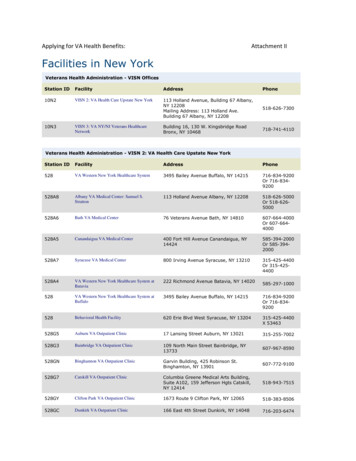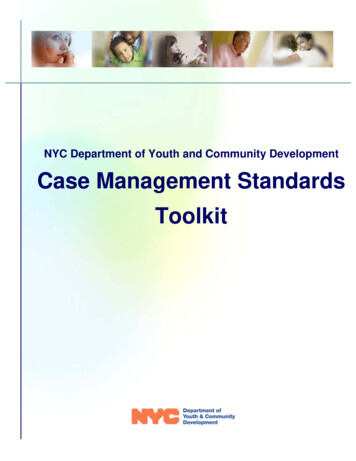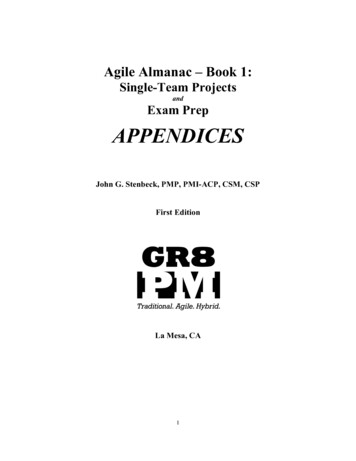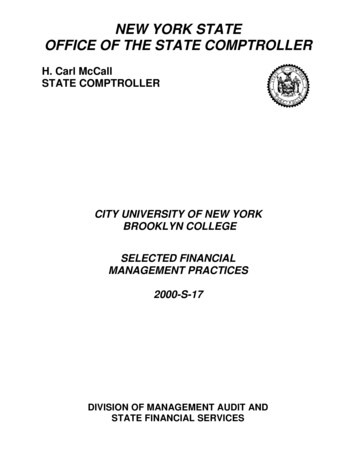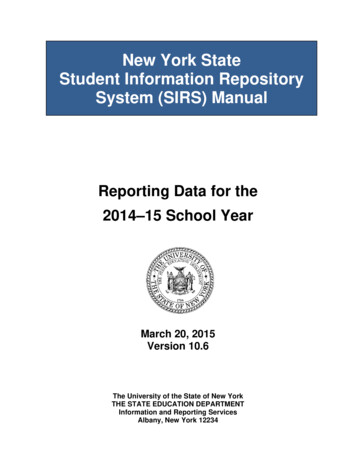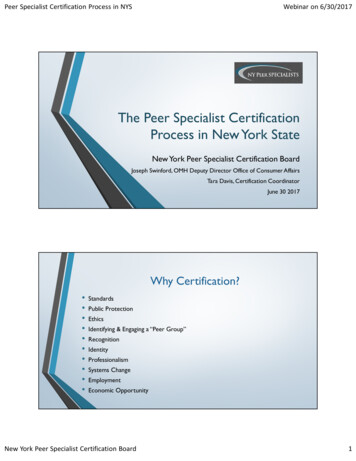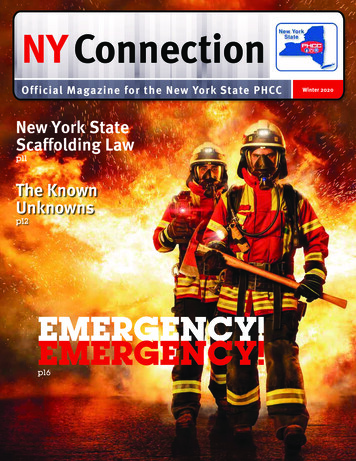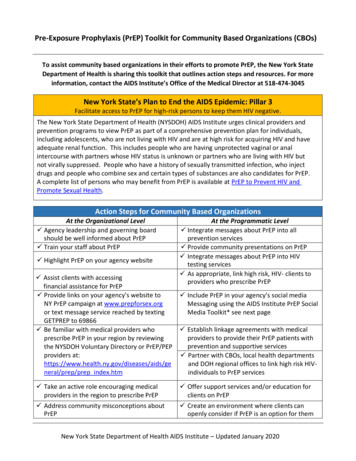
Transcription
Pre-Exposure Prophylaxis (PrEP) Toolkit for Community Based Organizations (CBOs)To assist community based organizations in their efforts to promote PrEP, the New York StateDepartment of Health is sharing this toolkit that outlines action steps and resources. For moreinformation, contact the AIDS Institute’s Office of the Medical Director at 518-474-3045New York State’s Plan to End the AIDS Epidemic: Pillar 3Facilitate access to PrEP for high-risk persons to keep them HIV negative.The New York State Department of Health (NYSDOH) AIDS Institute urges clinical providers andprevention programs to view PrEP as part of a comprehensive prevention plan for individuals,including adolescents, who are not living with HIV and are at high risk for acquiring HIV and haveadequate renal function. This includes people who are having unprotected vaginal or analintercourse with partners whose HIV status is unknown or partners who are living with HIV butnot virally suppressed. People who have a history of sexually transmitted infection, who injectdrugs and people who combine sex and certain types of substances are also candidates for PrEP.A complete list of persons who may benefit from PrEP is available at PrEP to Prevent HIV andPromote Sexual Health.Action Steps for Community Based OrganizationsAt the Organizational Level Agency leadership and governing boardshould be well informed about PrEP Train your staff about PrEP Highlight PrEP on your agency website Assist clients with accessingfinancial assistance for PrEP Provide links on your agency’s website toNY PrEP campaign at www.prepforsex.orgor text message service reached by textingGETPREP to 69866 Be familiar with medical providers whoprescribe PrEP in your region by reviewingthe NYSDOH Voluntary Directory or PrEP/PEPproviders /prep/prep index.htmAt the Programmatic Level Integrate messages about PrEP into allprevention services Provide community presentations on PrEP Integrate messages about PrEP into HIVtesting services As appropriate, link high risk, HIV- clients toproviders who prescribe PrEP Include PrEP in your agency’s social mediaMessaging using the AIDS Institute PrEP SocialMedia Toolkit* see next page Establish linkage agreements with medicalproviders to provide their PrEP patients withprevention and supportive services Partner with CBOs, local health departmentsand DOH regional offices to link high risk HIVindividuals to PrEP services Take an active role encouraging medicalproviders in the region to prescribe PrEP Offer support services and/or education forclients on PrEP Address community misconceptions aboutPrEP Create an environment where clients canopenly consider if PrEP is an option for themNew York State Department of Health AIDS Institute – Updated January 2020
AIDS Institute PrEP Social Media ToolkitIn June 2019, the AIDS Institute released a PrEP SocialMedia Toolkit for use by community partners andstakeholders. The toolkit features a diverse panel ofmodels and addresses three key topics related toaccessing PrEP: Is PrEP Right for Me? Where can I getPrEP? and What are my payment options? The toolkitprovides easy to use digital materials which are inEnglish and Spanish. The materials are sized to matchvarious social media platforms, such as Facebook, Twitter and Instagram. For more information aboutthis campaign and to sign up to participate, contact 518-474-3045 or email hivet@health.ny.govCheck out the toolkit /prep/social media toolkit.htmNew Developments in PrEP for Adolescents:Capacity to ConsentA 2017 amendment to the New York Codes, Rules and Regulations (NYCRR) grants minors the capacityto consent to PrEP, post-exposure prophylaxis (PEP) and HIV treatment without parental/guardianinvolvement, bringing capacity to consent to HIV-related services on a par with capacity to consent toother STD prevention and care. Clinical providers may, over time, discuss with their minor patientsopportunities for parental or guardian involvement in these decisions, including exploring with theyoung person the potential benefits of parental or guardian involvement. However, decisions about theinvolvement of a young person’s parent or guardian must be left to the young person. Clinical providersshould maintain a high level of sensitivity to the concerns of the young person regarding potentialnegative consequences of involvement of a parent or guardian. Discussions about whether to involve aparent or guardian should never result in a delay in starting HIV prevention or treatment services.For more information review the document titled HIV Testing, Reporting and Confidentiality in NewYork State, 2017-18 Update: Fact Sheet and Frequently Asked Questions which can be found s/testing/.Clinical IssuesOn May 15, 2018, the U.S. Food and Drug Administration (FDA) approved TDF/FCT (Truvada) use foradolescents weighing at least 35 kg ( 77 lb) at high risk of acquiring HIV. New York State ClinicalGuidelines state that clinicians should recommend PrEP for individuals, including adolescents*, who donot have but are high risk of acquiring HIV and have adequate renal function. (A1)See NYSDOH AI: Forum on PrEP for Adolescents: Successes, Challenges & Opportunities for an extensivediscussion of considerations for PrEP in adolescents.New York State Department of Health AIDS Institute – Updated January 2020
Tools and Resources:The following tools and resources can be found in Appendix 1 or on the NYS Department of HealthPrEP Webpage at: ep/prep index.htmInformation for Individuals Considering PrEP1. PrEP/PEP Voluntary Provider Directory to locate providers in your area2. Frequently Asked Questions for Consumers3. Link to www.prepforsex.org “HIV Prevention Just Got Easier” Public Campaign4. PrEP Yourself Against HIV – Consumer poster and brochure in English and Spanish5. PrEP Patient Assistance Program – financial assistance to cover health care costs of PrEP6. Payment Options for PrEP – summary document7. Link to the Drug Manufacturer’s Patient Assistance ProgramsInformation and Resources for Clinical Providers and Support Services Providers1. PrEP-AP for Providers: Information about How Providers can Enroll in PrEP-AP2. Link to Clinical Education Programs for PrEP Providers – www.ceitraining.org3. What Support Services Providers Should Know About PrEP: Fact Sheet4. For information about trainings on PrEP for Clinical and Non-Clinical Providers visitwww.hivtrainingny.orgNew York City Department of Health and Mental Hygiene PrEP h-topics/prep-pep-resources.pageIncludes information for consumers, FAQs, link to a directory of NYC providers, checklist for clinicspreparing to offer PrEP and other helpful materials.NYS PrEP Clinical Guidelines:New York State Clinical revention/PrEP Checklists and Management tion/prep/#tab 13US Public Health Service Clinical Practice Guidelines:Pre-exposure Prophylaxis for the Prevention of HIV in the United States: A Clinical Practice Guideline2017: -guidelines-2017.pdfTaking a Sexual History - Palm /csi/csi-prep-pep-sex-history.pdfNYS PrEP Consumer Education Materials Order Form:https://www.health.ny.gov/forms/order forms/prep.htmNew York State Department of Health AIDS Institute – Updated January 2020
SAMPLE HIV/STD/HCV Risk Screening ToolAdapted from Planned Parenthood of NYC Brief PrEP ScreeningPrEP is a daily pill for HIV-negative people. It protects you in case you are exposed to HIV in thefuture. If you say yes to any of the questions below, PrEP might be right for you.In the last 6 months, did you: Have sex without condoms with a person whose HIV status is unknown, who has untreated HIVor who is not HIV undetectable? Have a sexually transmitted infection (an “STD”), such as gonorrhea, syphilis, or herpes? Have sex while drunk or high? Have sex for something you needed (such as housing, money, drugs)? Share needles or injection supplies?In the last 6 months, have you had a sexual partner who: Refused to use condoms? Made you have sex when you did not want to? Had sex with anyone besides you? Injected drugs with a needle? Is living with HIV and has an undetectable viral load but you would like additional protection?If you answered yes to any of the questions, ask a health care provider about an HIV test and whetherPrEP might be for you.New York State Department of Health AIDS Institute – Updated January 2020
Note to Provider Conducting the Screening: Considerations: PrEP and PEPReference: prep/#tab 2Candidates who should be offered PrEP include individuals who:ooooooooooooo Engage in condomless sex with partners whose HIV status is unknown, or who have untreatedHIV, or who have unsuppressed virus while on treatment for HIV.Are attempting to conceive with a partner who has HIV.Are at ongoing risk of HIV acquisition during pregnancy through inconsistent condom use withsex partners who have unsuppressed virus.Have, or are involved with partners who may have, multiple or anonymous sex partners.Engage in sexual activity at parties and other high-risk venues, or have sex partners who do so.Are involved, or have partners who may be involved, in transactional sex (i.e., sex for money,drugs, food, or housing), including commercial sex workers and their clients.Have been diagnosed with at least 1 bacterial sexually transmitted infection (STI) in the previous12 monthsReport recreational use of mood-altering substances during sex, including but not limited toalcohol, methamphetamine, cocaine, ecstasy, and gamma hydroxybutyrate.Report injecting substances or having sex partners who inject substances, including illicit drugs,hormones, or silicone.Are receiving non-occupational post-exposure prophylaxis (nPEP) and anticipate ongoing risk orhave used multiple courses of nPEPRequest the protection of PrEP even if their sex partners have an undetectable HIV viral loadSelf-identify as being at risk without disclosing specific risk behaviors.Acknowledge the possibility of or anticipate engaging in risk behaviors in the near future.Do not withhold PrEP from candidates who:Are pregnant or planning a pregnancy.Use other risk-reduction practices inconsistently, including condoms.Report substance use.Have mental health disorders, including those with serious persistent mental illness.Report intimate partner violence.Have unstable housing or limited social support.Report a recent STI.Request PrEP even in they have a partner living with HIV with an undetectable viral load.ooooooooNew York State Department of Health AIDS Institute – Updated January 2020
PEP: Post exposure prophylaxis should be recommended and a referral for immediate medicalattention should be made when an individual reports a high risk exposure within the past 72 hours.Situations that may prompt an immediate referral for PEP include: Unprotected (condomless) receptive or insertive vaginal or anal intercourse with an HIVpositive partner or a partner whose status was unknown, including intercourse that involvedcondom slippage or breakage Unsafe needle-sharing; Injuries with exposure to blood or other potentially infected fluids from a source known to beHIV-infected or HIV status is unknown (including needlesticks with a hollow-bore needle,human bites, accidents)NOTE: For persons presenting with wounds or needlestick injuries, the site should be washedwith soap and water, avoiding irritation of the skin. The wound should not be “milked” orsqueezed. Squeezing the wound may promote hyperemia and inflammation at the woundsite, potentially increasing systemic exposure to HIV if present in the contaminating fluid. Lower risk exposures that require evaluation by a clinical provider on a case by case basisinclude: Oral-vaginal contact (receptive and insertive) Oral-anal contact (receptive and insertive) Receptive penile-oral contact with or without ejaculation Insertive penile-oral contact with or without ejaculationNOTE: The level of risk in these situations increases with presence of blood, genitalulcers, an STD or non-intact skin or mucus membraneNew York State Department of Health AIDS Institute – Updated January 2020
Key Messages About PrEPDescribing PrEPPrEP is an individualized plan to prevent HIV and promote sexual health. It involves taking the medication toprevent HIV. It is safe and effective. PrEP helps keep you healthy with regular screening for HIV and STIs.Effectiveness of PrEPPrEP is effective at preventing HIV. It is important to take the medicine as prescribed by your provider for it tobe most effective.Addressing Side EffectsSide effects don’t usually cause people to stop taking PrEP. You may have mild side effects. If you have them,they are usually short term. You should tell your provider about any side effects. The provider can work withyou to address any side effects that are bothering you.Addressing Cost IssuesThere are many resources to help make sure PrEP is affordable to you. There are resources to pay for themedication, to pay for your health appointments and testing, and help to pay for any co-pays you cannotafford. Information is available from a support provider or prep/docs/prep payment options.pdfPrEP, Stigma and ConfidentialityYour health is worth protecting. If you are concerned about what others may think about you because you aretaking PrEP, just remember, you don’t have to tell anyone you are taking PrEP.Having a Partner who is Living with HIVIf you are HIV negative and have sexual partners who are living with HIV,
information, contact the AIDS Institute’s Office of the Medical Director at 518-474-3045 New York State’s Plan to End the AIDS Epidemic: Pillar 3 Facilitate access to PrEP for high-risk persons to keep them HIV negative. The New York State Department of Health (NYSDOH) AIDS Institute urges clinical providers and prevention programs to view PrEP as part of a comprehensive prevention plan .
